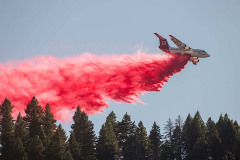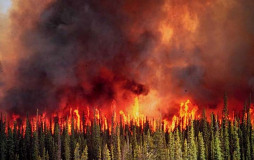No products in the cart.
More Close Calls
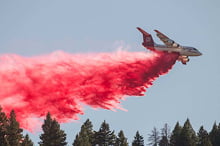
Dear Editor,
I enjoyed the article by Ray Brooks about his time with the Forest Service [“Close Calls,” IDAHO magazine, January 2023]. He and I were contemporaries in the agency for a few years. I worked on the Twin Falls Ranger District starting in the summer of 1970, and my last year was 1973. Much like Ray, I could earn enough during the summer to pay for my year of college. Reading his article brought back many fond memories of the four years I worked in the South Hills, so called because they are south of Twin Falls.
Ray mentioned in his article a man who had a bull-penis cane. I, too, worked with a man that had such a cane. His name was Red Wilson. I worked with him for just two very memorable days. There was a single-track trail in the South Hills that went up the Third Fork of Rock Creek Canyon. It was shared by motorcycle riders and horse riders. The motorcycle riders complained because there was a very sharp ridge and they would high-center their motorcycles going over it. Red Wilson was sent to remedy the problem and because I rode a motorcycle, I was assigned to work with him.
We rode cycles up to the offending high point, carrying a gas-powered rock drill on Red’s motorcycle. We spent a full day drilling twenty holes along that ridge. The next day we came back and Red stuffed dynamite in each of the twenty holes with different lengths of fuses. I watched as he lit two cigarettes, handed one to me, and said, “You light ten and I’ll light ten.” Then he turned to start lighting the fuses.
“I don’t smoke,” I replied.
“You better hurry and learn how.”
There I was, blowing on the end of the cigarette while he lit fuses. As it turned out, I think I lit five of the charges and Red got the rest of them. We ran downhill and dove behind a big rock. The dynamite blew, we got showered by small rocks, and the offending ridge was gone. After a little bit of cleanup we were finished, and I was done with my interaction with Red Wilson. But I still remember now, fifty-plus years later, trying to get my cigarette glowing enough to light the fuse on those dynamite charges.
I had two close calls that have stuck with me all these years. In the first one, we were fighting a fire south of Twin Falls in the foothills, mostly tall sagebrush. We had an old International two-seater pump truck that could haul six guys, the pumper in the back, and a few maintenance supplies. We were usually out doing maintenance work but when a fire came, we were brought into the action.
On this fire, I was working the nozzle and had my hose tender behind me. We were flanking the fire when all of a sudden our man who was at the truck began honking the horn and shouting and waving at us. We turned but could not understand what he was saying. When we turned back to the fire, we saw that the wind had suddenly changed and the fire was coming over the ridge right at us, moving fast. We dropped the hose and began running as hard as we could toward the truck. Just then, a plane came over the ridge and plastered us with fire retardant, which rolled us head-over-heels. The truck was also coated with a layer of orange retardant.
Fire retardant released over Boise National Forest, 2016. Kari Greer, USFS.
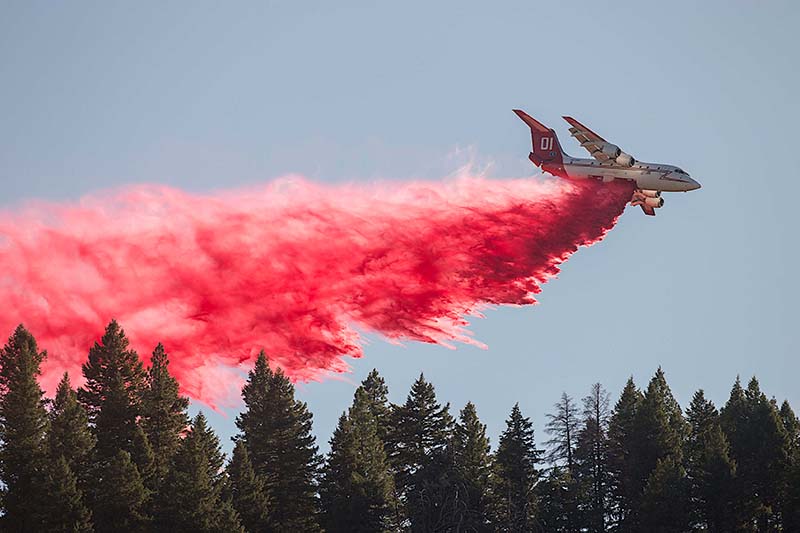
A crown fire. USFS.
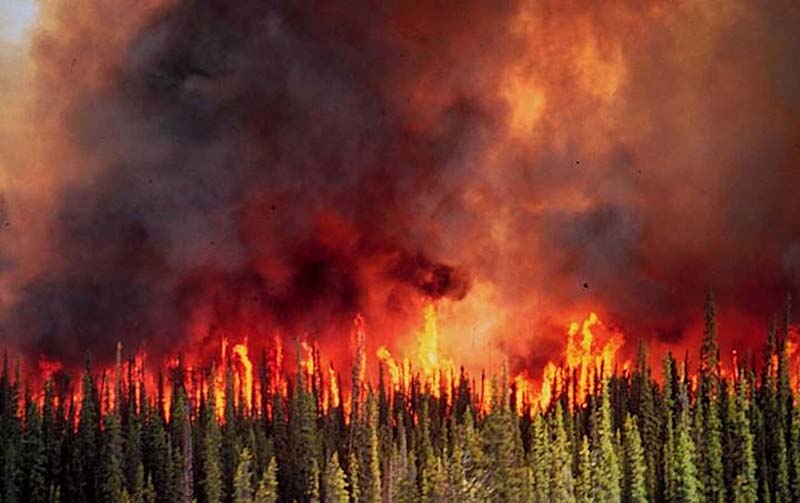
What an amazing sensation to be rolled over by the slurry—but it did protect us from the fire and we were able to use that little alleyway to get out of the way. We saved the truck but lost all of the hose, so we were no longer of any use.
The second exciting experience happened in August 1973. I remember that date because I had been married for a week and I’d gone back to work the first day after our honeymoon. That summer there were lots of fires, especially in Washington state, as I remember, so they were rounding up firefighters from the Forest Service districts. The helicopter picked me up at our workstation in the South Hills and flew us to the airport in Twin Falls, where we hopped on a prop plane, I don’t remember the size or model, but we flew directly to McCall. Once there, sixteen of us got into a Twin Otter smokejumper plane and flew to a backcountry landing strip called Cold Meadows. Here, eight of the passengers had to get out because they could only carry eight men at a time back to a more remote airstrip on what I remember was Big Creek (I could be wrong on some of these names). When we landed, the plane bounced two or three times, scaring the heck out of us, and pulled up into the trees to stop. We had to hop out, grab onto the tail, and pull the plane back around so the pilot could take off.
As I remember, we were there for a week to ten days. When I didn’t come home that first night, my wife got very worried. She phoned my dad, who then phoned the ranger to find out what had happened to me. No cell phones back then—and we never had a chance to use a pay phone. Later, because the Forest Service was so short of firefighters, they brought in Job Corps crews from Chicago and Tennessee. Some of those poor boys had never seen mountains. I can still see their wide eyes as they looked out the windows of the plane when it landed and bounced along the strip. Everything had to be parachuted in, all our supplies, our sleeping bags and everything else we needed. We had a fleet of six or seven helicopters that would ferry us up to the fire each morning and bring us back to the campground at the landing strip each evening.
The scary part happened when we were building a fire line. I think it’s called crowning, when the wind comes up so strong that the fire goes to the top of the trees and over your head. That’s what happened to us, and I can still remember the roar of the fire going over our heads. We did not know what we should do, but thankfully there was not much fuel on the ground and the fire eventually extinguished itself. It was my one and only experience with crowning.
One summer the Forest Service wanted us to get onto a fire as quickly as possible, so they based a helicopter near our workstation in the South Hills, which is close to the Magic Mountain Ski Resort. We had a Vietnam veteran pilot. He didn’t last very long because he thought it was pretty fun to fly low and buzz the organizational camps that were close by. The ranger was there one morning when he landed with quaking aspen leaves and small branches caught in his skids. He was gone the next day.
The helicopter was stationed at our work site and we had to take helicopter training at Big Smokey, above Fairfield. The chopper pilot was out of Hailey. I don’t remember his name, but I do remember hearing later that he was killed on the Salt Flats: flying low, lost his engine, and was too low to autorotate. At Big Smokey, he took us for a ride at the end of our training. He flew us from Big Smokey and around the Iron Mountain fire lookout. When he made the turn he dove down the canyon and laid the helicopter on its side and looked back and laughed at all the guys who were having a hard time keeping their breakfast down. I found I could handle a rough ride in a helicopter much better than a fixed wing plane. We trusted him because of his many hours of military training and I was sad to learn of his passing.
I worked primarily on the maintenance crew, becoming the crew boss my last year. My boss was a man from Buhl named Harry McCauley. He was a retired logger who worked summers for the Forest Service. He knew the South Hills like it was his backyard. Our first two jobs every spring were to check all the water troughs to make sure they were working, as well as the water supplies in all the campgrounds. Then we had to drive or walk the Deadline Ridge fence. Even then it separated the cattle from the sheep. It ran the full length of the South Hills.
The name Deadline Ridge came about because the cattlemen said to the sheep men, “If you cross this ridge, you are dead men” And they hired a gunslinger, Diamondfield Jack, to patrol the ridge to keep the sheepmen on their side to the east. Today I don’t see many sheep in the South Hills. Checking the water troughs and the Deadline fence is now done by the permittees, because the Forest Service does not have the budget to do so.
Well, I’ve rambled long enough. I just want to thank Ray Brooks for his article. It made me stop and write down some of these memories and to share them with my two sons.
Hoby Stanger
Twin Falls
Ray Brooks replies:
Hoby, thanks for supplying the name of our mule packer: Red Wilson. I later knew two of his half-brothers. His mother was a Stanley Basin legend, Dirty Dora, who ran the Beaver Creek Store and enjoyed shocking young men with her collection of risqué souvenirs.
Our helicopter pilot was Danny Danielson. He also worked winters, ferrying helicopter skiers at Sun Valley. I lost track of him, but he was still alive in the late 1970s, so hopefully he was not the pilot who crashed and died. The Sawtooth Forest road crew used to base at Hailey but since that station closed in 1972, it would make sense that they would have transferred to Twin Falls. My parents lived in Ketchum and had several friends their age on that crew.
Ray Brooks,
Hagerman
This content is available for purchase. Please select from available options.
Purchase Only
Purchase Only

